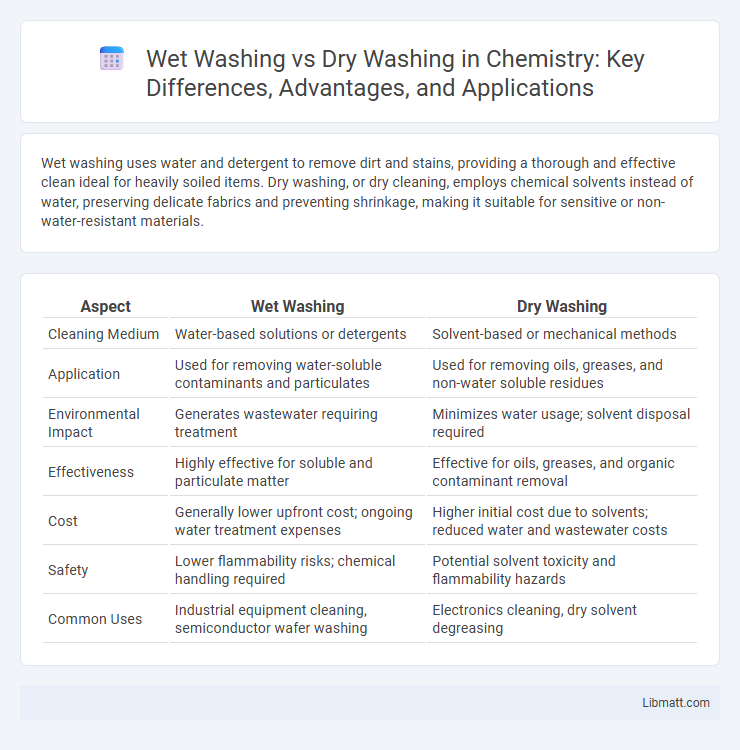Wet washing uses water and detergent to remove dirt and stains, providing a thorough and effective clean ideal for heavily soiled items. Dry washing, or dry cleaning, employs chemical solvents instead of water, preserving delicate fabrics and preventing shrinkage, making it suitable for sensitive or non-water-resistant materials.
Table of Comparison
| Aspect | Wet Washing | Dry Washing |
|---|---|---|
| Cleaning Medium | Water-based solutions or detergents | Solvent-based or mechanical methods |
| Application | Used for removing water-soluble contaminants and particulates | Used for removing oils, greases, and non-water soluble residues |
| Environmental Impact | Generates wastewater requiring treatment | Minimizes water usage; solvent disposal required |
| Effectiveness | Highly effective for soluble and particulate matter | Effective for oils, greases, and organic contaminant removal |
| Cost | Generally lower upfront cost; ongoing water treatment expenses | Higher initial cost due to solvents; reduced water and wastewater costs |
| Safety | Lower flammability risks; chemical handling required | Potential solvent toxicity and flammability hazards |
| Common Uses | Industrial equipment cleaning, semiconductor wafer washing | Electronics cleaning, dry solvent degreasing |
Understanding Wet Washing and Dry Washing
Wet washing involves using water and detergents to remove dirt and contaminants from surfaces or fabrics, making it highly effective for deep cleaning and removal of oil-based stains. Dry washing relies on specialized solvents or powders without water, minimizing moisture exposure and preserving delicate materials sensitive to water damage. Understanding the differences between wet washing and dry washing aids in selecting the appropriate cleaning method based on fabric type, stain characteristics, and environmental considerations.
Key Differences Between Wet Washing and Dry Washing
Wet washing uses water and detergent to clean fabrics, effectively removing dirt, oils, and stains through mechanical action and rinsing. Dry washing relies on chemical solvents instead of water, which are designed to eliminate grease and organic residues without soaking the fabric. Understanding these key differences helps you choose the appropriate method based on the garment's material and cleaning requirements.
Pros and Cons of Wet Washing
Wet washing effectively removes dirt, oils, and bacteria using water and detergents, making it ideal for heavily soiled fabrics and improving hygiene. However, it consumes more water and energy, potentially causing fabric shrinkage or color fading if not done properly. Your choice should balance cleaning needs with environmental impact and fabric care guidelines.
Pros and Cons of Dry Washing
Dry washing offers the advantage of conserving water, making it an eco-friendly option suitable for areas experiencing drought or water restrictions. It is quick and convenient, eliminating the need for lengthy drying times and reducing the risk of fabric shrinkage or color bleeding. However, dry washing may not effectively remove heavy stains or deeply embedded dirt compared to wet washing, potentially requiring additional spot treatment or professional cleaning.
Best Applications for Wet Washing
Wet washing excels in removing heavy soil, grease, and oil from work clothes, towels, and linens due to its use of water and detergent solutions. It is best suited for heavily soiled fabrics in industries such as automotive, manufacturing, and healthcare where thorough cleaning is essential. Your choice of wet washing ensures deep cleaning and effective stain removal, maintaining the fabric's integrity while addressing intensive dirt.
Ideal Situations for Dry Washing
Dry washing is ideal for delicate fabrics like silk, wool, and rayon that can shrink, fade, or become misshapen with water exposure. It effectively removes oil-based stains and dirt without risking water damage or color bleeding, making it suitable for suits, formal wear, and upholstery. Your garments maintain their shape and texture, ensuring longevity and a pristine appearance through professional dry cleaning methods.
Environmental Impact: Wet vs Dry Washing
Wet washing consumes significant amounts of water and often involves detergents that can introduce harmful chemicals into waterways, raising concerns about water pollution and resource depletion. Dry washing uses little to no water, reducing water usage and minimizing chemical runoff, making it a more eco-friendly option in arid regions or areas with limited water supply. Understanding these environmental impacts can help you choose a washing method that aligns with sustainability goals and conserves vital natural resources.
Cost Comparison of Wet and Dry Washing Methods
Wet washing typically involves higher water and energy consumption, leading to increased utility bills, while dry washing requires specialized solvents and equipment that can raise upfront and maintenance costs. Your choice between wet and dry washing methods will depend on balancing the ongoing costs of water, electricity, and detergents against the frequency and scale of solvent purchase and disposal fees. Evaluating local water rates, chemical prices, and environmental regulations can provide a clearer picture of the most cost-effective method for your washing needs.
Effectiveness on Different Fabrics and Stains
Wet washing excels at removing water-soluble stains like sweat, food, and dirt from cotton, linen, and synthetic fabrics by thoroughly penetrating fibers. Dry washing, using solvents, effectively targets oil-based stains such as grease and makeup on delicate materials like silk, wool, and rayon without causing fabric shrinkage. Choosing the right method ensures your garments maintain their integrity while achieving optimal stain removal.
Choosing the Right Washing Method for Your Needs
Selecting between wet washing and dry washing depends on fabric type and staining severity; wet washing excels at removing water-soluble dirt from cotton and synthetics, while dry washing suits delicate fabrics like silk or wool sensitive to water damage. Consider environmental impact as wet washing consumes more water and energy, whereas dry cleaning uses chemical solvents that require proper disposal to avoid pollution. Assessing garment care labels alongside stain analysis ensures the optimal washing method preserves fabric integrity and extends garment longevity.
wet washing vs dry washing Infographic

 libmatt.com
libmatt.com